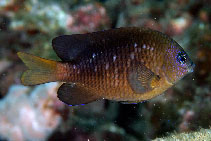http://www.fishbase.org/Summary/speciesSummary.php?genusname=Stegastes&speciesname=adustus ---> http://192.134.151.83/Summary/speciesSummary.php?genusname=Stegastes&speciesname=adustus
http://192.134.151.83/Summary/speciesSummary.php?genusname=Stegastes&speciesname=adustus ---> https://fishbase.mnhn.fr/Summary/speciesSummary.php?genusname=Stegastes&speciesname=adustus
https://fishbase.mnhn.fr/Summary/speciesSummary.php?genusname=Stegastes&speciesname=adustus ---> https://fishbase.mnhn.fr/summary/Stegastes-adustus.html
Stegastes adustus, Dusky damselfish : aquarium

You can
sponsor
this page
Common name (e.g. trout)
Genus + Species (e.g. Gadus morhua)
-

-
About this page
-
Languages
-
User feedbacks
-
Citation
-
Uploads
-
Related species
-


 Dusky damselfish
Add your observation in
Fish Watcher
Upload your
photos
and
videos
Dusky damselfish
Add your observation in
Fish Watcher
Upload your
photos
and
videos
Pictures
|
Google image
 Stegastes adustus
Stegastes adustus
Picture by
Rocha, L.A.
Teleostei (teleosts) >
Ovalentaria/misc
(Various families in series Ovalentaria) >
Pomacentridae
(Damselfishes) > Microspathodontinae
Etymology:
Stegastes:
Greek, stegastos, -e, -on = covered (Ref.
45335
)
.
More on author:
Troschel
.
Environment: milieu / climate zone / depth range / distribution range
Ecology
Marine; reef-associated; non-migratory; depth range 0 - 3 m (Ref.
7247
). Tropical; 32°N - 8°N, 98°W - 59°W
Western Central Atlantic: Florida, Gulf of Mexico, Caribbean Sea and along the coast of central America to Panama and Venezuela. Also known from the Bahamas and the Antilles.
Size / Weight / Age
Maturity: L
m
?
range ? - ? cm
Max length : 15.0 cm TL male/unsexed; (Ref.
26340
)
Dorsal
spines
(total): 12;
Dorsal
soft rays
(total): 14-17;
Anal
spines
: 2;
Anal
soft rays
: 13 - 15. Juveniles are reddish orange above, with small bright blue spots on forehead and dark spots at upper pectoral fin base, dorsal fin, and caudal peduncle; colors disappear as fish grows larger (Ref.
26938
). Adults dark gray to blackish with vertical black lines on body; a black spot, sometimes diffuse, at upper base of pectoral fins which are pale; other fins dark (Ref.
13442
).
Adults inhabit rocky shores exposed to wave action. Often in tide pools. Feed primarily on algae and detritus. Territorial and pugnacious. Generally common (Ref.
9710
). Oviparous, distinct pairing during breeding (Ref.
205
). Eggs are demersal and adhere to the substrate (Ref.
205
). Males guard and aerate the eggs (Ref.
205
). Taken incidentally in traps and small-meshed beach nets (Ref.
5217
).
Life cycle and mating behavior
Maturity
|
Reproduction
|
Spawning
|
Eggs
|
Fecundity
|
Larvae
Oviparous, distinct pairing during breeding (Ref.
205
). Eggs are demersal and adhere to the substrate (Ref.
205
). Males guard and aerate the eggs (Ref.
205
).
Allen, G.R.
, 1991. Damselfishes of the world. Mergus Publishers, Melle, Germany. 271 p. (Ref.
7247
)
IUCN Red List Status (Ref.
130435
)
Least Concern (LC)
; Date assessed:
15 November 2010
CITES
Not Evaluated
Not Evaluated
Threat to humans
Harmless
Human uses
Aquarium: commercial
FAO - Publication:
search
|
FishSource
|
More information
Countries
FAO areas
Ecosystems
Occurrences
Introductions
Stocks
Ecology
Diet
Food items
Food consumption
Ration
Common names
Synonyms
Metabolism
Predators
Ecotoxicology
Reproduction
Maturity
Spawning
Spawning aggregation
Fecundity
Eggs
Egg development
Age/Size
Growth
Length-weight
Length-length
Length-frequencies
Morphometrics
Morphology
Larvae
Larval dynamics
Recruitment
Abundance
BRUVS
References
Aquaculture
Aquaculture profile
Strains
Genetics
Electrophoreses
Heritability
Diseases
Processing
Nutrients
Mass conversion
Collaborators
Pictures
Stamps, Coins Misc.
Sounds
Ciguatera
Speed
Swim. type
Gill area
Otoliths
Brains
Vision
Tools
Bio-Quiz
|
E-book
|
Field guide
|
Length-frequency wizard
|
Life-history tool
|
Point map
|
Classification Tree
|
Catch-MSY
|
Special reports
Check for Aquarium maintenance
|
Check for Species Fact Sheets
|
Check for Aquaculture Fact Sheets
Download XML
Summary page
|
Point data
|
Common names
|
Photos
Internet sources
AFORO (otoliths) |
Aquatic Commons
|
BHL
|
Cloffa
|
BOLDSystems
|
Websites from users
|
Check FishWatcher
|
CISTI
|
Catalog of Fishes
:
genus
,
species
|
DiscoverLife
|
ECOTOX
| FAO - Publication:
search
|
Faunafri
| Fishipedia |
Fishtrace
| GenBank:
genome
,
nucleotide
|
GloBI
|
Google Books
|
Google Scholar
|
Google
| IGFA World Record |
MitoFish
|
National databases
|
Otolith Atlas of Taiwan Fishes
|
PubMed
|
Reef Life Survey
| Socotra Atlas |
Tree of Life
| Wikipedia:
Go
,
Search
| World Records Freshwater Fishing |
Zoological Record
Estimates based on models
Preferred temperature (Ref.
123201
): 26.2 - 28.3, mean 27.5 °C (based on 449 cells).
Phylogenetic diversity index (Ref.
82804
): PD
50
= 0.5000 [Uniqueness, from 0.5 = low to 2.0 = high].
Bayesian length-weight: a=0.01950 (0.00893 - 0.04257), b=2.99 (2.81 - 3.17), in cm total length, based on LWR estimates for this Genus-body shape (Ref.
93245
).
Trophic level (Ref.
69278
): 2.5 ±0.1 se; based on diet studies.
Resilience (Ref.
120179
): High, minimum population doubling time less than 15 months (Preliminary K or Fecundity.).
Fishing Vulnerability (Ref.
59153
): Low vulnerability (10 of 100).
Nutrients (Ref.
124155
): Calcium = 105 [52, 172] mg/100g; Iron = 0.724 [0.421, 1.239] mg/100g; Protein = 18.3 [17.1, 19.5] %; Omega3 = 0.0847 [, ] g/100g; Selenium = 16.2 [8.4, 32.9] μg/100g; VitaminA = 79.7 [20.8, 291.8] μg/100g; Zinc = 1.79 [1.18, 2.71] mg/100g (wet weight);
Back to Search
Random Species
Back to Top
Accessed through:
Not available
FishBase mirror site :
localhost
Page last modified by :
mrius-barile
- 20 July 2016
Fatal error
: Uncaught ArgumentCountError: Too few arguments to function checkEcotox(), 1 passed in /var/www/html/summary/speciessummary.php on line 2304 and exactly 3 expected in /var/www/html/includes/speciessummary.lib.php:2579 Stack trace: #0 /var/www/html/summary/speciessummary.php(2304): checkEcotox() #1 {main} thrown in
/var/www/html/includes/speciessummary.lib.php
on line
2579
|